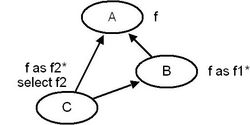Transposition
With the ECMA Eiffel Standard, the dynamic binding semantics of the Eiffel language are almost clearly defined. This new or clarified semantics have some interesting consequences. The following system shows the difference between how the dynamic semantics were (and still are) implemented and how they are specified in the ECMA standard:

|
local a: A b: B do create {C}a create {C}b a.f --Line 3 b.f1 --Line 4 end |
The semantics for line 3 have always been clear, feature f2 is called. For line 4 the ECMA standard says, that feature f1 is called, whereas the current ISE compiler choses feature f2.
Resolving of select conflicts
Transposition
We speak of the transposition of a feature, when we copy an inherited feature to a descendant class and adapt its content according to the inheritance path. When all the inherited features of a class are transposed, we get the flat short form of the class. Transposition is very interesting, since it seems to be the solution to some ambiguities in the language, namely repeated inheritance and replication. In the following system:
class B feature f do g end g do end end |
class D inherit B rename f as f1, g as g1 redefine f1 select f1, g1 end rename f as f2, g as g2 end feature f1 do ... end end |
class D has the transposed form (we omit the features from ANY):
So the transposed form of class D redefines all the features of its parent. Some rather complex rules of the standard become obsolete, when it is just stated, that every inherited feature needs to be transposed (8.16.2, 8.16.3, 8.16.4, 8.16.5). During the transposition there might be conflicts. It is possible that two transposed features have the same name. It remains to be specified how such cases are handled. One solution is to say, that they are valid iif their (transposed) body is equivalent.
Optimization possibilities for transposition
Apart from its power to describe the semantics of the language, transposition is very (maybe too) expensive. It is certainly not acceptable to really transpose every feature from a compiler designer point of view. So we need to find criteria to only transpose when really needed. The following system shows that this is not that easy:
What happens, when an object of class Y with its field a set to an object of class C has its feature g executed. Only the transposition of g to Y gives the answer:
g
do
a.f1
end
The covariant redefinition of a in Y resolved the potential repeated inheritance conflict. Nevertheless, if g wasn't transposed, feature f2 of class C would have been executed. So the transposition was reallly needed here. We may state:
- Every feature that uses a target of a covariant type needs to be transposed (Unqualified feature calls don't have a target).
This rule is actualy to restrictive. If our system wouldn't have contained the class C there wouldn't have been any need to transpose f. But such checks would be very expensive.
- If a feature is not transposition equal ....
Feature g of class X assumes We try to find out, wether it is necessary to really transpose feature g of class Y. The following code snippet gives the answer:
local y: Y c: C do create y create c
Transposition was never necessary in Eiffel compilers but it is now
For the following discussion we use this system of five classes:


